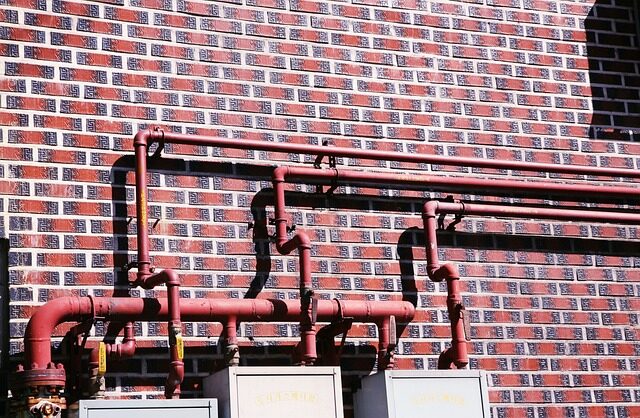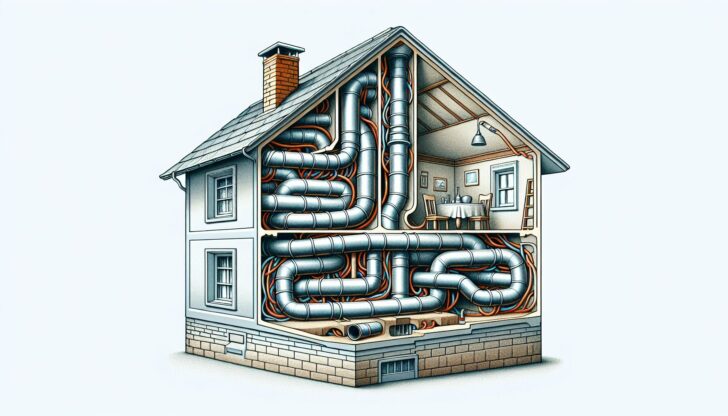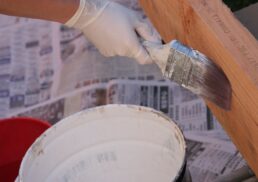Drain vents may be out of sight, but their role in your plumbing’s performance is anything but out of mind. Ensuring smooth drainage and clean air in your home, drain vents are pivotal components that prevent trouble before it starts. Discover their essential functions, how to keep them in check, and what to do if you suspect a problem – all without unnecessary jargon or fluff.
Table of Contents
Key Takeaways
Vent pipes are critical to maintaining air pressure balance within a home’s plumbing system, enabling efficient water and waste flow and preventing slow drains, standing water, and vacuum buildup that can hinder performance.
Proper ventilation via vent pipes helps prevent the accumulation of hazardous sewer gases in living spaces by directing them outside, ensuring the health and safety of the home environment.
Innovations like air admittance valves provide alternative venting solutions that can save space and cost while adhering to plumbing codes, especially useful in renovations or constructions where traditional venting is challenging.
The Vital Role of Vent Pipes in Your Home’s Plumbing System

Vent pipes are the unsung heroes of your home’s plumbing system, silently ensuring that every flush and every drain operates with the reliability you take for granted. These vital conduits maintain the essential air pressure balance within your plumbing system, allowing water and waste to flow smoothly and efficiently through drain pipes. Without vent pipes, you’d quickly notice a dire change; imagine the frustration of a sink that refuses to drain or a toilet that won’t flush properly—these are the symptoms of a plumbing system gasping for air.
In the architectural dance of pipes within your home, smaller conduits join forces with larger branch drains, all leading to the main stack—a vertical column that commands the movement of both waste and air. At the summit of this stack sits the stack vent, the overseer of ventilation, which bravely extends through your roof to keep the entire system in harmonious balance.
Understanding Air Pressure in Drainage Systems
Have you ever wondered why water in your sink drains down rather than up? The answer lies in the delicate balance of air pressure within your home’s drainage system. Without proper air pressure, water and waste could be left stranded in your pipes, leading to slow or even stagnant water flow—a homeowner’s nightmare. This is where your plumbing vents step in, drawing air into the system to prevent a vacuum that could disrupt the seamless transit of waste from your home to the sewer system.
Consider your plumbing air vent as a silent guardian that ensures your drains keep flowing smoothly. It’s the unsung hero that prevents slow drains, standing water, and the desperate reach for the drain cleaner. By allowing air to enter the pipes, your plumbing vent plays a pivotal role in maintaining the symphony of water flow that is so crucial to your daily life.
How Vent Pipes Keep Sewer Gases at Bay

Vent pipes perform the critical task of directing sewer gases away from your living spaces, ensuring you breathe easy within the sanctuary of your home. These gases, by-products of your household waste, are anything but pleasant and could pose health risks if allowed to accumulate indoors. Thankfully, your plumbing vent pipes serve as escape routes, channeling these unwanted guests up and out through your roof.
Yet, the venting system’s duty extends beyond mere expulsion of odors; it’s a bulwark against the drying out of your P-trap—the U-shaped pipe under your sink—which if left unchecked, can become a conduit for sewer gases to seep into your home. When vents are clogged, this protective water barrier can evaporate, turning your home into a den of unpleasant odors and potential hazards.
Decoding the Types of Plumbing Vents
Vent pipes come in various forms, each with its unique function and place in your home’s plumbing system. Vent stacks, also known as direct vents, stand tall and proud through your roof, playing a crucial role in alleviating pressures within the system for those larger branch intervals—think of them as the main arteries of your plumbing’s venting network.
On the other hand, the versatility of loop vents and common vents shines in more specific scenarios, offering solutions for complex fixture layouts where a standard vent stack might not suffice. Dive a bit deeper, and you’ll discover auxiliary vents, which rise from near the fixture’s drain line, crossing over to join forces with the main vent stack, ensuring even the most isolated fixtures can breathe freely.
With multiple options available for integrating vents into the stack—including sanitary crosses and revent pipes—plumbers have a veritable toolbox of solutions to ensure every fixture is properly vented, conforming to the needs of your home’s unique plumbing blueprint.
The Straightforward Stack Vent
The stack vent, often referred to as the true vent of your plumbing system, is the epitome of simplicity and effectiveness. Rising vertically from the drain lines, it provides an uninterrupted air passageway to the open sky, ensuring that fresh air can freely enter the system to balance pressure and facilitate drainage. It’s the stalwart pillar that doesn’t mingle with the messy business of transporting water but focuses solely on the vital task of ventilation. To better understand the layout and function of the stack vent, a plumbing vent diagram can be a helpful resource.
Installed within the skeleton of your house, the stack vent makes its exit through the roof without carrying a drop of water along its journey. This vertical pipe reaches beyond the highest horizontal drain connected to the stack, standing guard to ensure that air flow is never compromised, even as it scales the heights of your home.
The Versatility of Loop and Common Vents
While stack vents are the standard bearers, loop and common vents offer ingenious solutions for those plumbing challenges that demand a touch of creativity. Common vents come into play when you have fixtures on opposite sides of a wall, as they allow for a shared venting system that connects with the main stack via a sanitary cross—like a handshake across a barrier, ensuring both fixtures are properly vented.
Loop vents, on the other hand, are the mavericks of the venting world, often employed for standalone fixtures such as a freestanding sink. They form a closed circuit beneath the sink and then venture horizontally to meet the main vent stack. In situations where wet venting is restricted and other methods are impractical, loop vents present an alternative path that allows for independent ventilation without compromising on efficiency.
Navigating Wet Venting: A Dual-Function Solution
Wet venting is like a Swiss Army knife for plumbers—a versatile tool that serves a dual purpose. In this efficient method, a single pipe acts as both the drain for waste and the vent for air circulation, a particularly handy approach when dealing with multiple fixtures in close quarters. Ideal for bathroom groups on the same floor, wet venting allows for a neat and compact plumbing setup that saves space while ensuring that everything operates smoothly.
In a well-designed wet venting system, each fixture connects independently to a horizontal wet vent, which then transitions to the dry vent, ensuring that air circulation is maintained even as water flows through. With oversized pipes to accommodate both waste and air, and a system design that acknowledges the unlikely event of simultaneous fixture use, wet venting provides a reliable solution for those tight on space but not on plumbing needs.
The Efficiency of Wet Vents in Compact Spaces
The true genius of wet venting shines in the tight confines of compact bathroom layouts. By serving multiple fixtures with a single vent system, wet venting eliminates the need for a tangle of separate pipes, offering a streamlined solution that can be a godsend in smaller homes.
This approach is particularly effective for servicing back-to-back bathroom groups, where the proximity of fixtures allows for a minimalistic yet fully functional venting strategy.
When Vent Pipes Go Wrong: Identifying and Addressing Issues
Even the best-designed plumbing systems can encounter issues, and vent pipes are no exception. When things go wrong, the signs are unmistakable: slow drainage, the whiff of unpleasant odors, and an overall sense of your plumbing not performing up to par. These symptoms can arise from a range of issues, from simple blockages to more insidious damage such as leaks, cracks, and corrosion, all of which can compromise the efficiency of your plumbing system.
Identifying problems early is key to maintaining the health of your plumbing. Some common signs to watch out for include:
Slow-flowing drains
Gurgling sounds
Foul sewer smells in your home
Sediment buildup
Ice formation in colder climates
If you notice any of these signs, it’s important to address the issue promptly to prevent further damage to your plumbing system.
The Consequences of Blocked Vent Pipes
The consequences of a clogged vent pipe can range from mildly annoying to downright hazardous. Blocked vents create pressure buildup within your drainage pipes, which can manifest as gurgling noises, slow water flow, and persistent standing water that refuses to drain.
Additionally, water evaporation in the drain trap—a common occurrence when vents are blocked—can allow sewer gases to invade your home, compromising air quality and posing potential health risks.
Professional Solutions for Clogged Vent Pipes
When faced with a stubborn vent pipe blockage, sometimes the best course of action is to call in the professionals. A professional plumber has the expertise and specialized equipment to tackle persistent blockages, especially those deep within your plumbing system that are beyond the reach of a standard plumber’s snake or garden hose.
Addressing clogged vents may sometimes involve delving into the house’s internal walls, a task best left to those with the knowledge and tools to navigate the complexities of your home’s hidden plumbing network.
Learn more, visit How Does a Plumber Clean a Clogged Plumbing Vent?
Tailoring Vent Placement: Installation Best Practices
Proper vent pipe installation is not just a matter of following a blueprint; it’s about understanding the best practices that ensure your plumbing system operates efficiently and stands the test of time. When selecting vent pipes, factors such as size, material, and durability are paramount, as these attributes contribute to a reliable and long-lasting plumbing system. The installation itself requires precision and attention to detail, ensuring that vent pipes are positioned at the correct angle to prevent liquid retention and facilitate a clear path for airflow.
While it may seem like a simple task, installing vent pipes with the proper configuration is essential to avoid potential clogs and ensure that air flow is not disrupted. The horizontal sections of your vent piping, for instance, must be positioned a safe distance above the flood level of your fixtures, protecting your home from the risks of back-siphoning and flooding.
Maximizing Efficiency with Correct Vent Pipe Placement
Correct placement of vent pipes not only maximizes the efficiency of your plumbing system but also prevents a host of issues that could arise from improper installation. Innovative solutions like air admittance valves are now available, offering a streamlined approach to vent placement that can enhance building aesthetics and reduce the potential for roof leaks.
Ensuring that your vent pipes are correctly installed, level or plumb, and without unnecessary slopes, will help maintain the integrity of your home’s plumbing system for years to come.
Adhering to Plumbing Codes for Safe Installation
One cannot overstate the importance of adhering to plumbing codes when installing vent pipes. These regulations are in place to prevent issues such as toxic sewer fumes from entering your home and to mitigate water overflow problems.
Consulting with local plumbing services is crucial to understanding which vent pipes are suitable and permitted for use, ensuring that your plumbing system meets all necessary safety standards.
Innovations in Venting: Air Admittance Valves Explained
The ever-evolving world of plumbing has brought forth innovations like air admittance valves (AAVs), which simplify the venting process for multiple fixtures. These clever devices allow air to enter the plumbing system when waste drains, while gravity ensures that sewer gases remain trapped where they belong. The local codes dictate the application and limitations of AAVs, including the number of fixtures they can vent, offering installers flexibility in design and potential cost savings.
While AAVs can vent individual plumbing fixtures without needing to connect to the main venting system, it’s important to note that a building must still have at least one traditional vent penetration through the roof. The use of AAVs can be particularly advantageous during renovations or in specific construction situations where traditional vent extensions might be challenging.
The Convenience of Air Admittance Valves
Air admittance valves are a testament to the ingenuity of modern plumbing, providing a convenient and practical alternative when traditional venting methods are impractical. An air admittance valve shines in scenarios like island sink installations, where connecting to the main vent stack would be a significant challenge.
Home remodels or additions can also benefit from the use of AAVs, as they simplify the venting process without the need to tap into the main vent structure.
Summary
As we conclude this journey through the hidden corridors of home plumbing, it’s clear that vent pipes are pivotal to a home’s well-being. From the simple stack vent to the innovative air admittance valve, these components work tirelessly to ensure the smooth and silent operation of your plumbing system. They protect against the invasion of sewer gases, maintain efficient water flow, and offer versatile solutions for every plumbing challenge.
Armed with this knowledge, you can appreciate the complex symphony of vents that keep your home’s plumbing in harmony. Whether you’re planning a bathroom remodel or troubleshooting a gurgling drain, understanding the essentials of drain vents empowers you to make informed decisions and maintain the health and safety of your living space. Remember, what happens out of sight should never be out of mind, especially when it comes to the crucial world of vents.
Frequently Asked Questions
What are the rules for drain vents?
When it comes to drain vents, the vent should be within 5 to 6 feet of the fixture drain it serves to effectively equalize air pressure and prevent sewer gas entry. These guidelines should be considered for proper installation.
What is the main function of vent pipes in a home plumbing system?
Vent pipes in a home plumbing system are crucial for maintaining proper air pressure, enabling smooth water flow, preventing vacuum formation in drain lines, and expelling sewer gases safely outside the home through the roof.
Can a clogged vent pipe affect my home’s drainage?
Yes, a clogged vent pipe can significantly impact your home’s drainage, causing slow drainage, gurgling sounds, unpleasant odors, and potential sewer gas issues. It is essential to ensure vent pipes are clear to maintain proper drainage and air quality within your home.
Are air admittance valves a suitable replacement for traditional vent pipes?
In some cases, air admittance valves (AAVs) can be a suitable alternative for traditional vent pipes, particularly for individual fixtures where venting is challenging. However, local codes may still require at least one traditional vent through the roof to ensure proper ventilation.
What is wet venting, and when is it used?
Wet venting is a plumbing method where a single pipe serves as both the drain for waste and the vent for air circulation. It is used for fixtures located in close proximity to create a more efficient and compact plumbing setup. It must be properly designed to handle both functions without issues.









